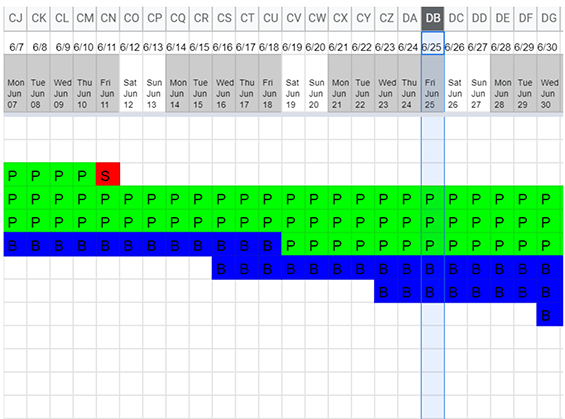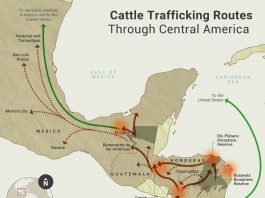
My family and I operate Wrong Direction Farm in Upstate New York. We sell our pasture raised chicken, turkey and grass fed beef directly to customers in our region. On our farm, pasture raised broiler chickens are the largest and most complex enterprise. The poultry don’t require as much land base as our beef herd, but they are far more intensive as measured by the dedicated infrastructure, the annual spending, and our daily labor.
In the early days, running a few batches of chickens did not require much forethought. But as I expanded the chicken operation, I began to encounter problems with congestion points. As we grow we can usually forecast some of the obvious changes required to reach a new production level. For example, I know I can’t add cows indefinitely without eventually adding extra bulls. But it is not as obvious that at certain growth points I will need to implement new management tools.
Unfortunately, I often do not know I have reached that point until things start going sideways. I shudder to think of some of the wrecks I have plowed into at full speed because I did not have the management experience and tools to understand the perils I faced. Our “uh-oh” moment with broilers came when we had four hundred chickens ready to come out of the brooder, but the field shelters were still occupied. I had previously changed a date with the hatchery and failed to foresee that it created a one-week pinch point in our schedule. Hastily built, half adequate shelters were the panicked solution, but I wasted time and money and put everyone else here through unnecessary stress.
After that debacle and a few smaller scheduling problems, I knew I needed a better solution for full-season planning. I played with several ideas before developing a grazing chart for poultry. I settled on a spreadsheet that allows me to enter dates for each batch. It automatically shades in color-coded patches on a calendar. Everything is laid out in an intuitive daily format to help me see at a glance where I might be setting myself up for trouble or where I have extra openings in my schedule. I’ve used the version I’m sharing with you for the last four years. Over that time it has become an invaluable business tool.
What a Poultry Grazing Chart Does

Unlike the ruminant grazing charts commonly discussed here at On Pasture, my chicken grazing chart is not focused on planning which fields will be used. For most pastured poultry farmers, chickens are not crowding out all the acreage, so we are not normally constrained by land area. Our bigger constraints are based on equipment and schedule. We need to be able to tell at a glance how many chickens will be in the brooder, in the field shelter, or going to the butcher on any given day.
With a well-designed chart I can plan my schedule months in advance. This provides me an opportunity to think ahead, to play with different scenarios, and to ask important questions like:
• How does my hatching schedule look?
• Can my hatchery support it?
• Will I have time to sanitize, dry, and reset my brooders before the next batch arrives?
• Are there any points in my schedule when I’ll have too many chickens for the available shelters?
• By which day must I complete my new shelter?
• How does my slaughter schedule lay out compared to my projected sales?
• Can my catching crew and butcher support these dates?
• How much margin do my plans have in case a date slips?
Profitability challenges for northern poultry producers like me are exacerbated by the short pasture season. If we were in a warmer climate we could be more leisurely about scheduling gaps, but with a short pasture season we need to make every week count. As I design my production calendar I need to ensure I am maximizing the throughput of my brooders and field shelters because these are expensive, depreciating assets. These assets cost us to own them, so it makes financial sense for them to be earning revenue rather than weighing down our ledgers.
How it Works
Here’s a link to download your own spreadsheet. To use it for your poultry, you may fill in any field with a yellow background. Everything else is a formula field, so be careful not to edit elsewhere unless you really know what you are doing with spreadsheets. Editing a non-yellow field can cascade errors through the sheet. If you have a firm background in formulas and conditional formatting, then feel free to go wild.
In my example below, you will see I have set my calendar start date (cell C1) to March 21st. This is a one-year calendar, but I normally select a starting date close to my first hatch date of the season. In cells A3 through F3 and each row below them I have added the critical data for sequential batches of chickens. You can see that I am able to plan for extra time for earlier batches if they must remain in the brooder longer due to cold weather. I can also adjust for different grow-out periods depending on my target weight for each batch. Columns G, H, and I automatically calculate the days the chicks will arrive in the brooder, go out to pasture, and go to slaughter, respectively.

Farther across the spreadsheet color coded cells light up to show the calendar view based on the dates you entered previously. Blue cells with the letter “B” are for days when birds are in the brooder. Green cells with the letter “P” are for birds on pasture. And the bright red day at the end? Well, you can probably figure that out…
Below is a sampling of dates as I scroll through the month of June.

If I look at June 25th, I know that I have three groups on pasture and two groups in a brooder. I can also look ahead and know that by June 30th I must prepare a third brooder to receive a batch of chicks.
Is this grazing calendar a perfect fit for your farm? Perhaps not. Maybe you have different constraints that I have not envisioned. But I present this as a tool for further development for your own needs. Please copy and adapt it as you like.
One thing I have always loved about the pastured poultry community, indeed the whole grazing community, is the open source attitude. The poultry aggregators and the national suppliers are all buttoned up with trade secrets, non-disclosure agreements, and intellectual property. That has never been the ethos among our kind of farmers. As the national brands elbow their way into our markets, we as smaller producers will need to continue to rely on each other to develop farm-scale pasture poultry systems that support our farms’ livelihoods, thrill our customers, respect the nature of our chickens, and improve our pasture management.
Want More?
Visit Wrong Direction Farms website for more on what they’re doing.





Ignore my previous comment. I pasted the wrong link… Here’s the correct one:
https://docs.google.com/spreadsheets/d/1d0-wlJ6GOYKCu7VbPIRimJEr2NvMsc6akROBuyAu3rs/copy
This should give you the spreadsheet in Google sheets format.
LibreOffice doesn’t seem to be fully compatible with all the formulas that Google Sheets and Excel uses.
Thanks, Dave
I just tried opening the file in the Windows version of LibreOffice and it doesn’t look like LibreOffice handling the Excel file correctly.
I originally developed the spreadsheet in Google sheets, so here’s the link for that:
https://docs.google.com/document/d/1×1-SkoPJbj1bBZi9ulVsmAMRD5KagmQ1Ai610bLU4aw/edit?usp=sharing
Let me know if that works for you.
Thanks, Dave
Comments are closed.